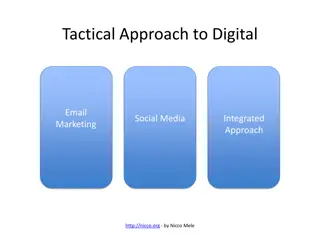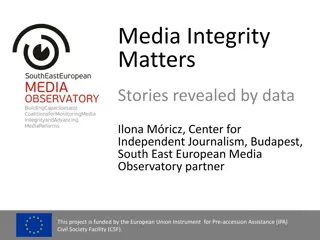
ESG Investing Trends and Tech for Sustainability in Law
Explore the growing market of ESG investing and the pivotal role of AI and technology in its development. Discover strategies like negative and positive screening, ESG integration, best-in-class investing, and thematic investing. Understand the impact of sustainable finance policies in different regions and the shift towards ESG factors in investment decisions.
Uploaded on | 0 Views
Download Presentation

Please find below an Image/Link to download the presentation.
The content on the website is provided AS IS for your information and personal use only. It may not be sold, licensed, or shared on other websites without obtaining consent from the author. If you encounter any issues during the download, it is possible that the publisher has removed the file from their server.
You are allowed to download the files provided on this website for personal or commercial use, subject to the condition that they are used lawfully. All files are the property of their respective owners.
The content on the website is provided AS IS for your information and personal use only. It may not be sold, licensed, or shared on other websites without obtaining consent from the author.
E N D
Presentation Transcript
AI AND ESG AI & The Future of Law University of Glasgow School of Law Ida Levine 2 December 2020
Introduction ESG (Environmental Social Governance) or sustainable investing is a rapidly expanding market Commercial and regulatory drivers mean ESG is becoming mainstream AI and Tech critical to orderly development of the market Investee companies can provide tech solutions with environmental and social themes Need for transparency with global, consistent and comparable data provided by companies and financial market participants Several angles to a very broad topic: Tech for Good Data collection and providers Measurement and Reporting Product Marketing and Distribution Engagement with pension scheme members
ESG trends Traditionally, investors made decisions based solely on financial factors - goal of maximizing risk-adjusted financial returns Increasingly, environmental, social and governance ( ESG ) factors are part of investment Global assets applying ESG data to drive investment decisions has almost doubled over 4 years, and more than tripled over 8 years, to $40.5 trillion in 2020 [Source: Pensions and Investments] Sustainable Finance is a pillar of economic policy in the EU and UK other regions to follow EU Sustainable Finance Action Plan UK has promised to match ambition post-Brexit US has lagged behind with retrogressive retirement plan rules; Biden Administration likely to change course Pandemic has reinforced appetite for ESG and placed emphasis on the S alongside the E new mantra is Build Back Better [Source: FT article, Moral Money, 14 October, 2020]
What is ESG investing? Investment managers use different strategies/processes Negative Screening excludes companies failing to meet pre-set ESG criteria e.g., alcohol, tobacco or gambling or cluster munitions/land mines Positive Screening uses investment research to find companies that address ESG concerns well, e.g., net zero economy (renewable energy, solar and wind power businesses) ESG Integration factors relevant ESG factors into investment decision-making defined by UNPRI as [t]he systematic and explicit inclusion of material ESG factors into investment analysis and investment decisions Best in Class invests in companies that are leaders in their sector in meeting ESG criteria e.g., tobacco or mining companies rather than excluding them Thematic Investing investing with a specific ESG issue e.g., Green or social housing funds A better approach is to look at an investor s intention or purpose on the Spectrum of Capital
Tech for Good ESG considerations are not only about responsible investment processes and strategy can be used to help identify attractive tech investments Tech for good refers to tech companies providing solutions to key challenges facing the world - e.g., AI in hospitals, ride sharing, electric or autonomous vehicles Investors looking for tech companies with impact to achieve positive social and environmental outcomes Accelerator programmes and funding programmes help charities looking to use tech to achieve their aims BUT not without challenges: 67% of CEOs think that AI and automation will have a negative effect on stakeholder trust within the next 5 years [Source: PWC] Companies looking to address broader stakeholder concerns about: job security future of work safety and privacy concerns
Tech for Good cont. Vast body of technical work on harnessing AI to address ESG issues PwC/WEF research on applying to tackle environmental challenges McKinsey research on using AI to smooth disruption and improve well-being AI has potential to address health issues applications ranging from diagnosis of pneumonia, malaria, or Alzheimer s to prediction of strokes and heart attacks, or of autism in infants robotics, has potential in surgery and other areas
Data Collection Data is at the heart of ESG investing but it is a confusing, fragmented universe ESG scores are provided by a diverse and proliferating group of rating agencies there are over 600 ESG ranking and ratings and over 4,000 ESG key performance indicators [Source: Euromoney] Historically, investors obtained data from companies Publicly available or from questionnaires or other sources Largely uncoordinated and burdensome for companies More detailed regulatory demands means information from data providers is increasingly important; asset managers concerned about data-gap MSCI has around 1/3 of the market; S&P Global, FTSE Russell, ISS ESG and Sustainalytics also providing services [Source: Euromoney] Challenges: collecting self-disclosed data from companies, need for verification and cross-checking; regulators concerned about the lack of consensus on ratings
Measurement and Reporting Given challenges around data collection and use this area is key priority for regulators EU has taken the lead with the Non-Financial Reporting Regulation and Green Taxonomy Will incorporate double-materiality reporting of impact of ESG on a company s business/value and of company s activities on environment and society New concept of Dynamic materiality UK FCA/HMT separately reviewing Taxonomy and other Sustainable Finance reg post-Brexit IFRS (global accounting standard setter) consultation; new Sustainability Standards Board IOSCO committee on ESG reporting; coordinating with sustainability standard setters Group of Five: GRI, CDP, IIRC, TCFD, SASB GRI/SASB collaboration and IIRC/SASB merger announced fit between IFRS and standard-setters will be key Data management is key data providers at the forefront while coherent, transparent and accessible reporting framework evolves Need for a central clearinghouse for ESG data next generation of SEC s EDGAR
Marketing and Distribution Proliferation of on-line platforms available to buy retail ESG products e.g., Abundance, Barclays Smart Investor major stockbrokers platforms Advice gap need for AI and tech solutions Robo-advisers use algorithms to invest e.g., Wealthify Risks include miss-selling, green/ESG washing Proposed new EU rules require ESG integration in asset manager and fund investment and operational processes Suitability Product Governance Due diligence/resourcing/governance
Pension Schemes: Member engagement Since 2012 Generation auto-enrolment placed in workplace pensions Scheme members may engage more with pensions invested according to ESG principles [Source: Legal & General and NEST] L&G research with Tumelo will tech solutions turn good intentions into concrete actions? [Source: Pensions Expert] On-line platform inspired by social media Access to pension dashboard with funds/investments Ability to cast votes at AGMs view other scheme member/provider votes Most users from younger age bracket 25-34; breakthrough for bringing early savers into pension journey Interest in investee companies 1/3 of users viewed site on a monthly basis






















